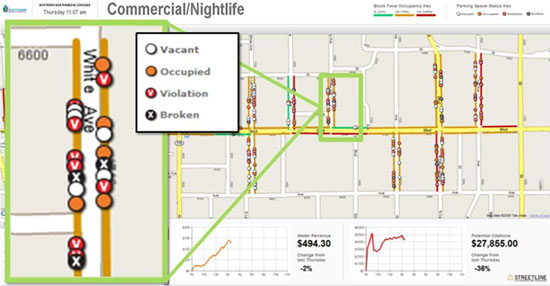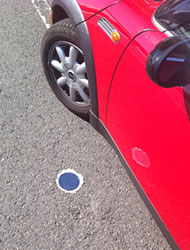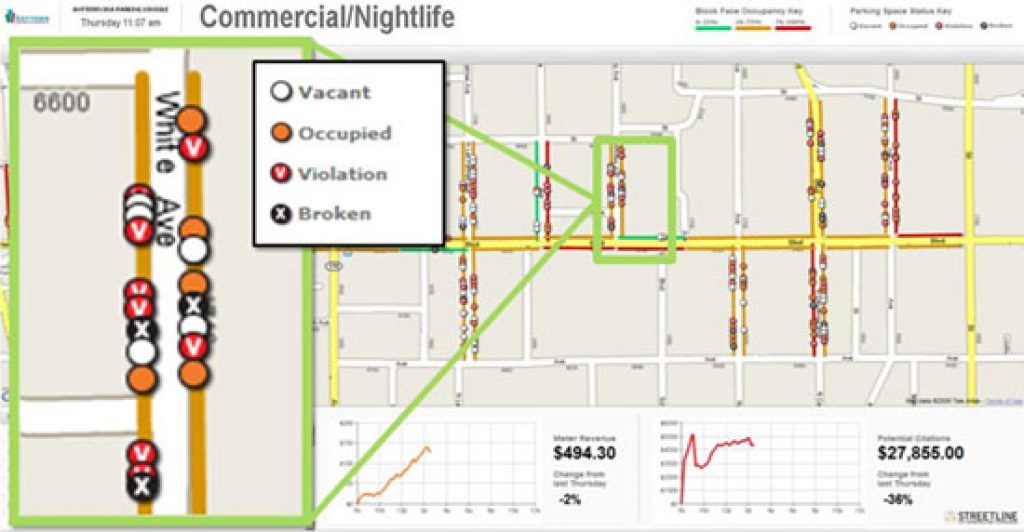A couple of weeks ago, I discussed a mesh networking system employing smartphones' cellular data links, which enabled vehicles to maximize gas mileage and minimize time spent sitting at red lights. Cars and trucks not only go, they also sometimes stop, specifically at parking spots. But finding an available and sufficient-sized spot is often a frustrating (and gas-wasting) experience for the person behind the steering wheel. And once you find a place to 'dock' your 'ship', you're once again frustrated when you need to pump quarters into the nearby meter (not to mention if you forget to do so, and return to find a ticket on your windshield)…aggravations that sometimes compel folks to park (and spend their money) elsewhere.
The latter twist is one that my hometown, Truckee, regularly debates. Merchants claim that limited parking spot availability, coupled with metering expenses, compel folks to avoid shopping and dining in the downtown tourist strip. But those same merchants are unwilling to alternatively shoulder the roadway and sidewalk maintenance expenses that metered parking revenues currently finance. All of this explains why a post to Slashdot yesterday, referencing an article in IT World Magazine, caught my eye. IBM has partnered with San Francisco-based startup Streetline to offer an integrated parking analytics system. Streetline supplies the self-powered (presumably by solar cells, coupled to batteries for overnight use) wireless mesh-based sensors, both attached to the pavement at each parking spot and to the associated parking meter. IBM supplies the servers. And the two companies jointly developed the data-processing software running both on the servers and on mobile devices.
For drivers, Streetline's Parker app for Android and iOS alerts you to available spots in proximity to your current location (and specifically, to ones with time remaining on the meter)…just please only use Parker while you're pulled to the side of the road, and keep your eyes on the road (and off your smartphone or tablet) while you're driving! Then there's the potential for handset-based payment schemes, timer-based reminders of pending expirations, and directions from the parking spot to your final destination (and back again…no more getting lost!). For city planners, the system provides abundant useful real-time data; which spots are (and aren't) being regularly used, for example, as well as the elasticity effects of experiments to raise and lower the time-based parking fee. And for parking enforcement officers, the ability to quickly identify violators is perhaps already so obvious that it doesn't need to be mentioned.

Streetline's online documentation is nebulous as to the specific technology used by the pavement-mounted sensor:

but it's clearly not currently an embedded vision application, judging from the following privacy-themed quote:
Our sensing systems excel at identifying specific physical conditions and events, like parking spaces becoming occupied or vacant, or water pressure in a fire hydrant. They use tiny amounts of energy to collect this data, and send it in simple messages over the network. We’ve spent years engineering to get the absolute most value out of the absolute fewest bits, to make sure we can keep our sensors in the field for years at a time. Streaming video? Even streaming audio, or still images? Not a chance. We don’t have the bandwidth. Which is just fine with us. We want to monitor systems to serve people — not the other way around.
Even though today's iteration of the concept isn't image sensor-based, a future enhancement might be, as wireless network bandwidth, battery capacities and solar cell efficiencies all improve with time. Wouldn't a large-vehicle driver like to know, for example, if the parking spot he's aiming for is only MINI-sized? What other system enhancements can you think of that would beg for an image capture-based parking analytics approach?


